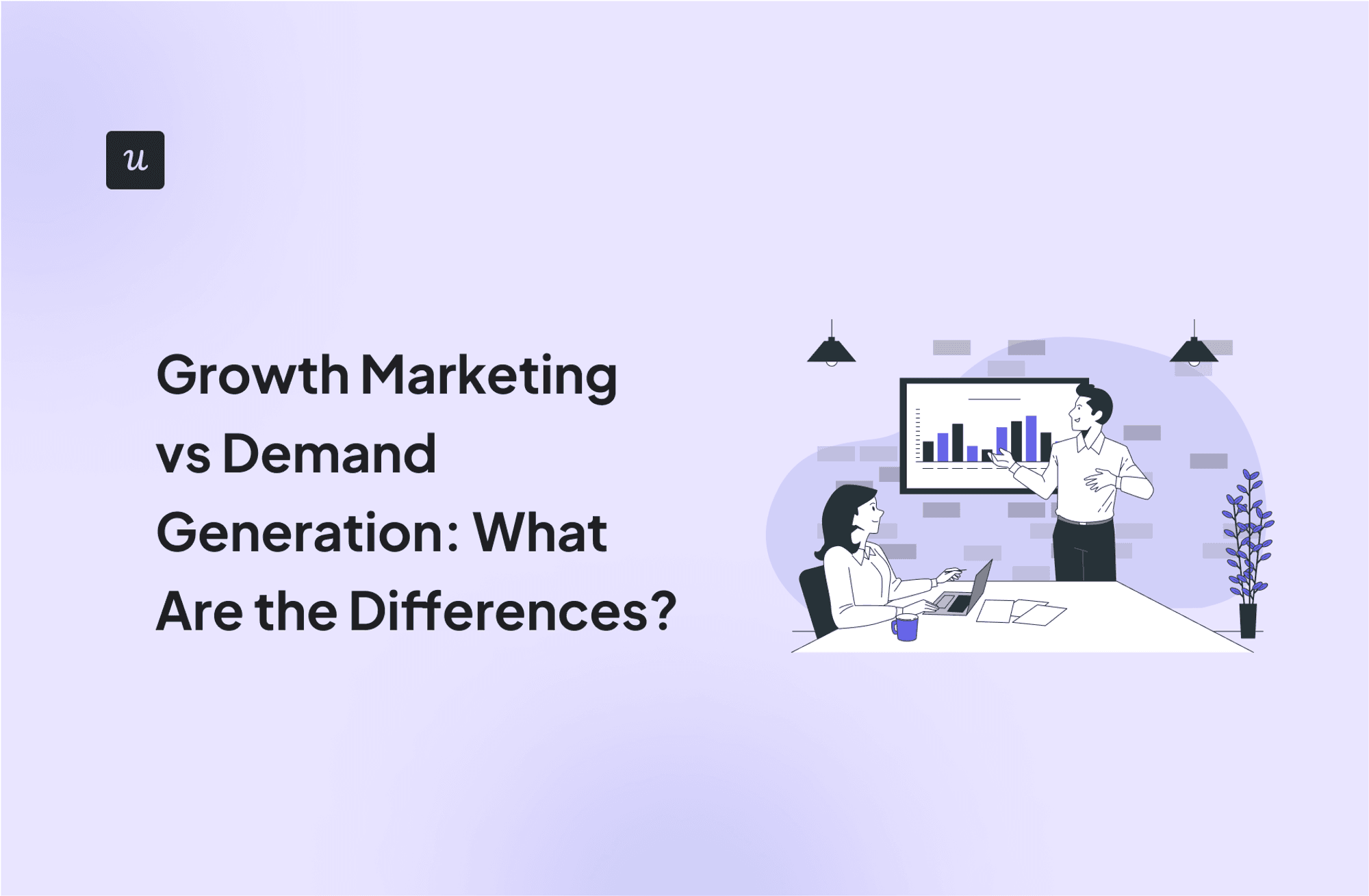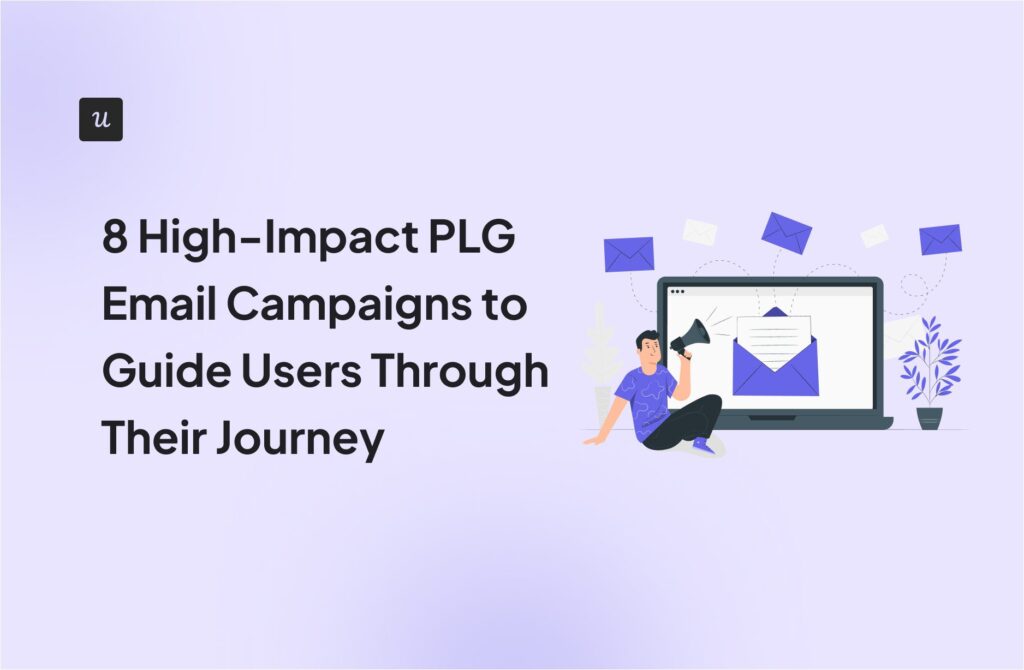
The age-old question: growth marketing vs demand generation, which one should you focus on?
Both are useful tools for optimizing your marketing strategy, helping you boost product growth and lead generation.
But first, it’s important to start with the basics. What do these terms mean, how are they different, and which one is right for you? We have all the answers right here, so let’s dive in!
Get The Insights!
The fastest way to learn about Product Growth, Management & Trends.
What is growth marketing?
Growth marketing is a strategy for driving long-term, sustainable growth through rapid customer acquisition and retention.
Growth marketers don’t solely work on product marketing to drive revenue growth. Rather, they focus more on how to reach new customers while retaining existing ones by finding ways to create a loyal customer base.
To do that, growth marketing makes use of data-driven product experimentation and optimization. This way, you’re not just acquiring new customers – you’re acquiring the right ones that are more likely to stick.

What is demand generation?
Demand generation focuses on creating awareness and cultivating interest in your product or service. By promoting your product, the goal is to generate qualified leads and drive sales.
To achieve that goal, demand generation starts with analyzing customers’ needs. Once you know what potential users want, you can create relevant content and awareness campaigns that better resonate with them.
Growth marketing vs demand generation: Goals
The ultimate goal for both growth marketing vs demand generation is to achieve sustainable business growth.
However, the two marketing tactics play different roles in helping realize that goal. Let’s dig deeper and see how.
Growth marketing goals
There are multiple growth marketing goals companies look to fulfill, the most common of which are discussed below:
- Rapid customer acquisition & activation: The goal isn’t just customer acquisition, but also to speed up activation and improve retention rate. All these things combine to boost revenue growth.
- Identify growth opportunities: Perform product analytics, like funnel analysis, to spot user leakage. These drop-off points serve as areas of improvement you can utilize to drive growth.

- Plan strategies: Growth marketing is all about experimenting and using those insights to continuously iterate and design more effective growth strategies.
Demand generation goals
Unlike growth marketing, demand generation comes with its own set of goals, which include:
- Create brand awareness: Recognition is crucial for building user trust and driving customer engagement. And the first step to achieving greater recognition among prospects is building awareness.
- Generate leads & nurture prospects: Successful demand-generation activities are meant to garner interest from prospects and guide them through the sales pipeline, thereby converting them into leads.
Growth marketing vs demand generation: Metrics
Let’s look at all the key metrics to know about for both marketing tactics.
Key metrics for growth marketing
- User acquisition cost (CAC): Measures the average amount of money your company needs to spend, with regards to the cost of sales and marketing efforts to acquire a new user.
- Customer lifetime value (CLV): This represents the average revenue you can expect to generate from a single customer throughout their relationship with your business.
- Churn rate: Calculates the percentage of customers who stop using your product or discontinue their relationship with your business during a specific period.
- Activation rate: Reflects the percentage of customers who complete a desired action after engaging with your product, such as making a purchase or filling out a form.
- Retention rate: Opposite to churn rate, this measures the percentage of customers who continue using your product over a specific time.
Monitoring all these growth marketing metrics on your own can be a time-consuming and complex task.
That’s why tools like Userpilot make things easier by enabling you to track growth metrics with no-code analytics dashboards. Plus, in addition to available templates, you can also create custom dashboards of your own.

Key metrics for demand generation
- Lead generation: Focuses on the quantity and quality of new leads generated, nurtured, and moved along the sales funnel toward becoming paying customers.
- Conversion rate: Measures the percentage of visitors or trial users who become paying customers of your business.
- Marketing-qualified leads (MQLs): The number of potential customers interested in your product and fit for your business, as reviewed by the marketing team.
- Sales-qualified leads (SQLs): The number of potential customers that are ready to make a purchase and in the final stages of the sales funnel, as reviewed by the sales team.
Growth marketing vs demand generation: Funnels
Both growth marketing and demand generation have a common aim of acquisition and customer retention. However, the two focus on different stages of the customer journey and utilize distinct funnels to meet that aim.
Growth marketing funnel
The most commonly used framework for growth marketing is the pirate funnel, aptly named so because it’s abbreviated as AARRR: Awareness, Acquisition, Activation, Retention, Referral, Revenue.
The funnel makes sense for growth marketing because it doesn’t just end with customer acquisition and activation.
Rather, it emphasizes what comes next, like customer retention and referral.
So you focus on not just acquiring customers but also ensuring that they stick around for longer and bring others on board as well.

Demand generation funnel
For demand generation, the most often used framework is the TOFU, MOFU, BOFU model. This framework helps you segment leads into top-of-funnel (TOFU), middle-of-funnel (MOFU), or bottom-of-funnel (BOFU). This segmentation is done depending on where the lead is in their customer journey.
Once you know where leads stand in the funnel, you can tailor marketing efforts for that segment to increase the chances of conversion.
Growth marketing strategy examples
There are numerous ways to utilize growth marketing tactics to drive rapid and s growth. Let’s look at a few of these use cases to better understand marketing strategies in action.
Personalize experiences to maximize customer lifetime value
A productive growth marketing strategy doesn’t just focus on acquiring customers but also on retaining them for longer. A great way to do so is by providing personalized customer experiences.
Personalization helps reduce the time to value and eliminate any friction points. All this ties together to increase customer lifetime value and improve loyalty, which translates into greater brand advocacy as well.
To start personalizing user experiences, try using welcome surveys. They are a great tool for capturing data on user roles, use cases, and jobs-to-be-done (JBTD). Next, you can use the collected data to present customers with relevant onboarding materials to guide them in the right direction.

Use path analysis to optimize customer experience
A useful growth marketing tactic is path analysis, which helps uncover how users navigate through your product. By analyzing these paths, you can identify common activity patterns leading to conversion or recurring pain points hindering progress.
These insights enable you to make informed decisions for improving navigation and providing a smoother customer experience.
Let’s say you want to monitor the user flow from signing up to reaching activation. With path analysis, you can examine whether users follow your guidance or if there is a better alternative than your existing onboarding plan.
Once you find the answer, you can refine onboarding flows accordingly, adding in-app guidance where needed to nudge customers in the right direction.

Implement a growth loop to increase the user base
Growth loops are extremely effective growth marketing tactics for creating self-reinforcing systems, where one customer’s action triggers another.
You automate growth by reinvesting the output of one cycle as the input for the next cycle to get more customer sign-ups.
The strategy involves embedding marketing into your product so that a user’s public output continues to produce new inputs.
Commonly used growth loops include user-generated content, referral programs, social sharing features, etc.

For example, you can introduce the option for new users to invite their coworkers or share updates with them. This form of shareability performed by one customer acts as input for others, leading to organic user acquisition.

A/B test different upsell prompts to boost conversion
If you notice that conversion rates aren’t as impressive as they should be, it’s time to play around with different upsell prompts.
A/B testing is a great tool for such growth experimentation. You can create various prompt versions and monitor which customers engage with more. For example, create one version with a GIF and the other with a micro video.
By the end, you’ll be able to make a data-driven decision on which prompt to use to improve conversion and maximize revenue.

Examples of demand generation strategies
By now, you know what the goal for demand generation is, how to measure the results, and which funnel to use.
Let’s see some demand-generation strategies in action. This will help you learn how to successfully execute them yourself as well.
Provide helpful content to attract and engage potential leads
Demand generation focuses on creating awareness among your target audience to cultivate leads. The easiest and yet most effective way of accomplishing this is through content marketing.
For example, you can create thought leadership articles, blogs, case studies, nurture email sequences, etc. All these marketing resources will improve brand visibility and help prospects learn more about your company and the product value you offer.
Beware though – content marketing doesn’t mean churning out content merely for the sake of it. Everything you create should be directly linked to your demand generation efforts and ultimately help drive business growth.

Host webinars to help with lead generation
Webinars let you showcase how your product is relevant to the customer’s context and helps solve their specific problems. They’re a fantastic way of generating leads through interactive discussions, enabling you to explain in real time the value your product offers.
For example, take a look at Userpilot’s webinar calendar. You’ll see that there are webinars covering a variety of customer issues, as well as the option of requesting on-demand training.

Use product demos and trials to facilitate customer acquisition
Before potential customers can commit to a product, they need to know if it’s worthwhile. To figure out the answer, product demos and free trials can be of great help.
Both tools allow prospects to experience product value firsthand. Plus, with interactive demos, any issues users have can be answered right there, helping boost engagement and interest. Similarly, during trials, interactive onboarding guidance makes it easier for users to understand your product.
Just ensure that you make it easy for users to sign up for trials and demos, for example, by implementing the SSO sign-up flow.

Conclusion
Now that we’ve covered the growth marketing vs demand generation debate, it’s worth noting that you don’t have to pick between both of them.
So, instead of deciding which strategy is the best, focus on understanding their differences and leveraging their respective metrics and funnels to your benefit.
Want to get started with growth marketing and demand generation? Get a Userpilot Demo and see how you can unlock sustainable growth in no time.





![10 Upsell Email Examples That Drive Conversions [+ Best Practices to Learn from Them] cover](https://blog-static.userpilot.com/blog/wp-content/uploads/2025/07/10-upsell-email-examples-that-drive-conversions-best-practices-you-can-learn-from-them_3f04b94940147631fa7cb7df795caedc_2000-1024x670.png)